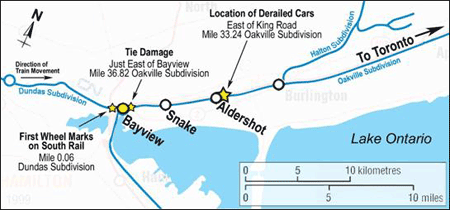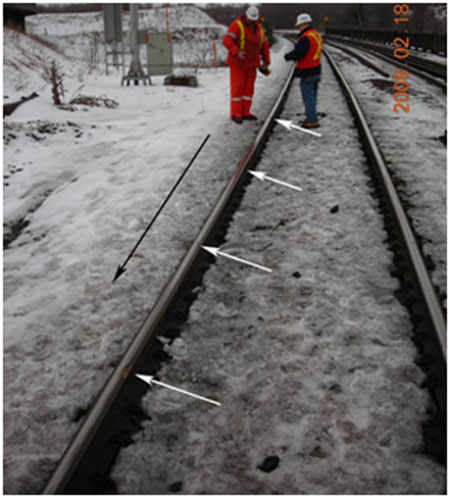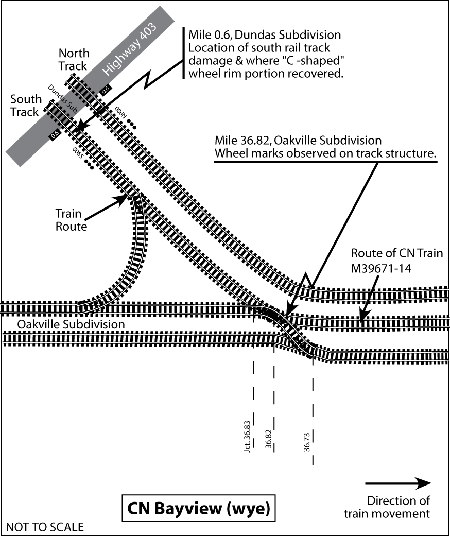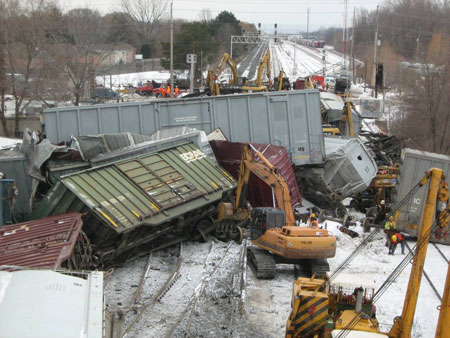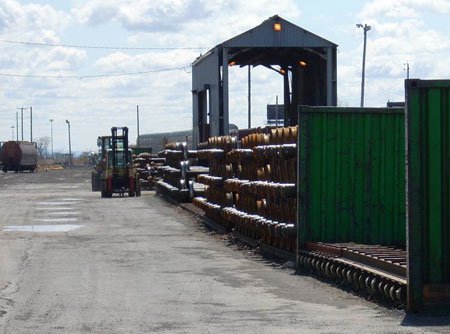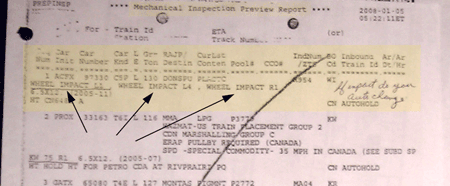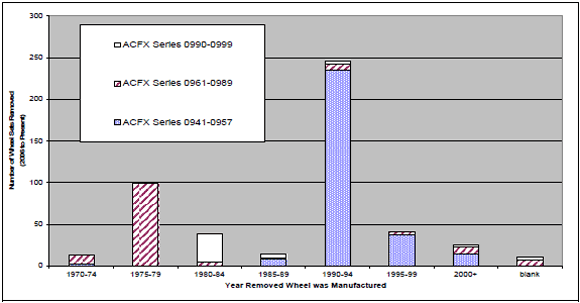Main-track derailment
Canadian National Railway
Freight train M39671-14
Mile 33.24, Oakville Subdivision
Aldershot, Ontario
The Transportation Safety Board of Canada (TSB) investigated this occurrence for the purpose of advancing transportation safety. It is not the function of the Board to assign fault or determine civil or criminal liability. This report is not created for use in the context of legal, disciplinary or other proceedings. See Ownership and use of content. Masculine pronouns and position titles may be used to signify all genders to comply with the Canadian Transportation Accident Investigation and Safety Board Act (S.C. 1989, c. 3).
Summary
On 18 February 2008 at 0054:37 Eastern standard time, eastbound Canadian National freight train number M39671-14 experienced an undesired emergency brake application at Mile 33.24 of the Oakville Subdivision while proceeding at 43 miles per hour through Aldershot, Ontario. Twenty cars derailed including five residue tank cars-three last containing sulphuric acid (UN 1830) and two last containing sodium hydroxide (UN 1824). There was significant structural damage to a neighbouring industrial building, but there were no injuries and no dangerous goods were released.
Ce rapport est également disponible en français.
Factual information
On 18 February 2008 at approximately 0052:52 Eastern standard time (EST)Footnote 1, eastbound Canadian National (CN) train number M39671-14 (train 396) was passing through CN's Aldershot Yard at 43 mph en route from Sarnia, Ontario to Toronto, Ontario. The train consisted of 3 locomotives and 139 cars (including 79 loads, 43 empties, and 17 residue tank cars). It weighed 11 908 tonnes and was 8027 feet long. The crew consisted of a locomotive engineer and a conductor. They were qualified for their positions, familiar with the territory and met fitness and rest standards.
A CN crew performing an inspection on the passing train observed sparks coming from the first car of a group of three hopper cars towards the back of the train. The inspecting crew immediately contacted train 396. During communications, train 396 experienced an undesired emergency braking event (UDE). The crew followed emergency communication procedures, while train 396 came to a stop. Cars from the train were piled up east of the King Road crossing, in the vicinity of Mile 33.24 of the Oakville Subdivision (see Figure 1).
The temperature was 5°C and the sky was overcast. The winds were from the southwest, gusting to 60 km/h.
Inspection of the track west of the derailment site revealed a large "C-shaped" portion of wheel rim (see Photo 1a) and impact marks on the head of the south rail, south track (see Photo 1b) at approximately Mile 0.6 of the Dundas Subdivision. At this location, the train was exiting a right-hand curve where CN tracks cross over Highway 403 before entering a wye junction with the Oakville Subdivision at Bayview (see Figure 2).
Rail damage extended eastward, through the east leg of the wye (a left-hand curve) onto the number 2 track of the Oakville Subdivision where the first signs of tie damage were observed at Mile 36.82 (see Figure 2). Three additional large pieces of a broken wheel were located at a damaged crossover switch at Snake (Mile 36.22). Track damage continued from this point to the King Road crossing at Mile 33.31.
On the west side of the King Road crossing, there were impact marks on the crossing apron to the gauge side of the north rail and to the field side of the south rail. East of the crossing, the 99th to the 108th cars were derailed, piled up, and jackknifed across the right of way (see Photo 2). Some cars had spilled down an embankment to the south onto private property. Many of the derailed cars were crushed, punctured, or leaking product. Two buildings at the derailment site were struck. One sustained serious structural damage.
Continuing east, two box cars (the 97th and 98th cars) and two covered hopper cars, ACFX 36706 (the 96th car) and ACFX 96349 (the 95th car), were on their side. Truck components, including wheels, bolsters, side frames brake rigging, and a straight-plate wheel set with one broken wheel were tangled under the lead end of ACFX 36706 (see Photo 3).
This wheel set, along with recovered wheel fragments, was sent to the TSB Engineering Laboratory for analysis (TSB Engineering Laboratory report number LP 040/2008).
Further to the east was a third hopper car, ACFX 97330 (the 94th car). This hopper car was also rolled on its side to the south and coupled to four residue tank cars (the 93rd to 90th cars). The most easterly derailed car was car PROX 16541 (the 89th car), a residue tank car, last containing sulphuric acid (UN 1830). It remained connected to the head end of the train with its trailing truck derailed.
Approximately 120 metres (400 feet) of track east of the King Road crossing was damaged or destroyed, including portions of all three main tracks and signal structures.
Particulars of the track
In the vicinity of the derailed cars, the Oakville Subdivision consists of three main lines. Train operations were controlled by the Centralized Traffic Control System, authorized by the Canadian Rail Operating Rules (CROR), and supervised by a rail traffic controller (RTC) located in Toronto. The authorized timetable speed was 95 mph for passenger trains and 60 mph for freight trains. On the day of the derailment, a Train General Bulletin Order (TGBO) was in effect, restricting the main track speed between Mile 36.4 and Mile 32.7 to 60 mph for passenger trains and 40 mph for freight trains.
In the vicinity of where wheel impact marks were first observed-Mile 0.60, Dundas Subdivision-the track was classified as Class 5 according to the Railway Track Safety Rules. It consisted of 136-pound, continuous welded rail manufactured in October 1984 and laid on hardwood ties in good condition. The rail was secured with four spikes per tie on 14-inch, double-shouldered tie plates and anchored every tie. The crushed rock ballast was in good condition and had approximately 18-inch shoulders.
Mechanical information
Car ACFX 97330 was a low-mileage covered hopper car designed for 268 000-pound general service. The car was operating in a pool of cars transporting pelletized Polyvinyl Chloride (PVC) from Geismar, Louisiana to Donspur, Quebec. Cars in this service are used for both product transportation and storage. For many of the cars in this service, weeks can pass before they are offloaded and returned to the shipper for reloading.
The car was built in 1977 by ACF Industries LLC (ACF), a manufacturer based in St. Charles, Missouri. Between 1970 and 1984, ACF primarily built covered hopper cars for hauling grain products. In 1997, ACF leased, and later sold, most of its hopper car fleet along with rights to use the ACFX trademark to General Electric. Over the years, ACF also sold hopper cars in small quantities to other independent car owners, such as the Essex Hybrid Seed Company (EHSX). The remaining fleet is owned by ACI Leasing, an affiliated company.
Recorded information
An analysis of the locomotive event recorder (LER) information from train 396 determined:
- From 0044:32 to 0046:46, power braking (the throttle was advanced with automatic brake applied) was applied.
- From 0046:19 (approximately eight minutes prior to the derailment), when a 12 pounds per square inch (psi) automatic brake reduction was released, no additional braking was applied. Recorded speed was 32 mph when the brake was released.
- From 0047:35 (approximately seven minutes prior to the derailment), the throttle was steady in position eight.
- Train speed increased from 34 mph to 43 mph in the 2.5 minutes prior to the emergency brake application.
- At 0054:37, a train-initiated emergency brake application occurred when the train was travelling at 43 mph.
- The head end of the train came to a stop at Mile 32.18 of the Oakville Subdivision.
Wheel impact measurements for car ACFX 97330
Wheel impact load detectors (WILDs)Footnote 2 are installed at strategic locations along the track to identify shelled, flat, out of round, or broken wheels which exceed impact thresholds. Cars in PVC pool service between Louisiana and Quebec pass over five CN WILD detectors. Table 1 summarizes the measurements for car ACFX 97330 since January 2007 that exceeded an impact threshold (thus triggering an alarm).
On 03 January 2008, car ACFX 97330, travelling eastward over the WILD site at Clark, Ontario, had measured wheel impacts of 137.5 kips (1 kip =1000 pounds) at the L1 location and 146.4 kips at the L4 location. Wheel impacts exceeding 90 kips are condemnable under Association of American Railroads (AAR) interchange rules.
Following CN's WILD policy and procedures, a General Bulletin Order (GBO) was issued to the handling train on 03 January 2008 at 0224 EST. The train was allowed to proceed to the next convenient location under a speed restriction of 57 mph. The car was placed in "bad order" status, with Taschereau Yard identified as the planned set-out location. The mechanical department at Taschereau Yard was alerted, through an automatically-generated work order, to arrange for the repairs on car ACFX 97330 when it arrived.
| Car ACFX 97330 | L1 | R1 | |||||||||||
|---|---|---|---|---|---|---|---|---|---|---|---|---|---|
| Date | Dir | Site Location | Entry Speed | Nominal Reading (kips) | Peak Reading (kips) | Ratio | Corrected Speed Reading | Ratio | Nominal Reading (kips) | Peak Reading (kips) | Ratio | Corrected Speed Reading | Ratio |
| 29-Dec-07 | L1 | Bentonia, Illinois | 31.7 | 33.386 | 87.2 | 2.61 | 98.2 | 2.94 | 36.088 | 107.3 | 2.97 | 122.4 | 3.39 |
| 2-Jan-08 | L1 | Aldershot, Ontario | 39.5 | 33.14 | 106.8 | 3.22 | 116.4 | 3.51 | 31.77 | 90.3 | 2.84 | 97.9 | 3.08 |
| 3-Jan-08 | L1 | Clarke, Ontario | 62.7 | 30.521 | 137.5 | 4.51 | 137.5 | 4.51 | 31.774 | 98.7 | 3.11 | 98.7 | 3.11 |
| 3-Jan-08 | L1 | Cedars, Quebec | 34.4 | 32.623 | 107.6 | 3.30 | 120.9 | 3.71 | 30.898 | 98.4 | 3.18 | 110.4 | 3.57 |
| 5-Jan-08 | L1/R1 wheel set changed out at Tachereau Yard | ||||||||||||
| 17-Feb-08 | L4 | Wakelee, Michigan | 47.7 | No data provided | No data provided | ||||||||
| L4 | R4 | ||||||||||||
| 29-Dec-07 | L1 | Bentonia, Illinois | 31.7 | No data provided | No data provided | ||||||||
| 2-Jan-08 | L1 | Aldershot, Ontario | 39.5 | No data provided | No data provided | ||||||||
| 3-Jan-08 | L4 | Clarke, Ontario | 62.7 | 31.88 | 146.4 | 4.59 | 146.4 | 4.59 | 26.839 | 118.1 | 4.40 | 118.1 | 4.40 |
| 3-Jan-08 | L4 | Cedars, Quebec | 34.4 | No data provided | No data provided | ||||||||
| 5-Jan-08 | No record of L4/R4 wheel sets changeout | ||||||||||||
| 17-Feb-08 | L4 | Wakelee, Michigan | 47.7 | 35.861 | 105.4 | 2.94 | 108.2 | 3.02 | 31.297 | 98.7 | 3.15 | 101.3 | 3.24 |
Repairs conducted on car ACFX 97330 at Taschereau Yard
When car ACFX 97330 arrived at Taschereau Yard, it was cut out of the train and transferred to the expedited repair track facility at track W01 (see Photo 4) for wheel change-out. The applicable repair ("bad order") code was specified as WI (wild impact).
The repair facility features a hydraulic drop tableFootnote 3 protected by a tall, tin-sheathed building. The building is open on two sides to permit rolling stock access. In addition, there is a large open doorway on a third side to permit access for various repair equipment. The work area is illuminated, but provides only limited protection from the environment.
On 05 January 2008, a mechanical crew, consisting of a lead hand and two carmen, was assigned to the expedited repair track facility to perform repairs on various cars. The mechanical crew was provided with a Mechanical Inspection Preview Report (see Photo 5). The report lists the cars placed for repairs in W01. In addition, basic information about each car (including the "bad order" code indicating why the car was set out for repairs) and a one line description of the required work is summarized on the report.
As specified on the Mechanical Inspection Preview Report for 05 January 2008:
- car ACFX 97330 was identified as requiring work.
- The "bad order" code for car ACFX 97330 was WI (wheel impact).
- There were three locations on car ACFX 97330 which were identified with high-impact wheels: L1, L4, and R1.
Completed billing records indicate that the number one axle was changed-out. The number four axle was not changed-out.
Designation of repair tracks
Appendix A of the Field Manual of the AAR Interchange Rules (2008) defines a shop or repair tracks as:
a location properly equipped, primarily and regularly used for repair of freight cars. Repairs must be done in compliance with FRA [Federal Railroad Administration] Railroad Freight Cars Safety Standards, Safety Appliance and power brake laws, and AAR Interchange rules.
At Taschereau Yard, the repair facility at track W01 is designed for wheel change-outs and is considered an "Expedite Repair Track". As per AAR rules, cars placed for repairs on an Expedite Repair Track do not require a full inspection by a qualified carman after the repairs are completed.
Work process for changing out wheels at Taschereau Yard
The work process for wheel change-out on track W1 at Taschereau Yard is summarized as follows:
- When a car is placed in "bad order" status for wheel change-out, an electronic, computer-generated notification is sent to the repair facility. "Bad order" notices are organized sequentially by car position in the repair track or expedite repair track.
- On the Mechanical Inspection Preview Report (the work order), all repairs to a specific car are identified and are printed on one line. The work order is printed and a hard copy is provided to the work crew.
- Work at this repair facility is normally performed in crews of three workers: a lead hand and two carmen.
- A trackmobile is used to position cars for the repair. A forklift is used to remove and replace the worn or defective wheel set.
- The forklift operator, in radio communication with the other crew members, has an enclosed cab protected from the weather. The operator normally handles the billing paperwork (see Photo 6).
- During wheel change-outs, a crew member is positioned on each side of the car. As each work activity is completed, the line item is manually struck out on the work order.
- When a biller is on duty, the AAR billing data for the removed wheel and its replacement is radioed to the biller. When there is no biller on duty, the complete billing paperwork is left on the biller's desk at the end of shift and the car is placed in the outbound track (W07).
- On an expedited repair track, there is no requirement for a full inspection of the car by the repair crew or any other mechanical staff to ensure that all car defects have been noted and repaired. However, mechanical supervisors are required to conduct random samplings of cars in the outbound repair track each month.
- WWhen a wheel change-out is completed, the biller enters the completed work information into the billing system and releases the car from "bad order" status. If a car in track W07 has not been released from "bad order" status when a yard assignment is ready for pickup, Yard Operations must call the lead hand to release the car.
A work order is treated as a single job, whether or not there are multiple job activities. During busy periods, billing entry can fall behind by two or three weeks. When this occurs, completed cars are released back into service by a supervisor or another mechanical employee authorized to release cars. A single-day CN system sampling in July 2008 identified 277 cars bad-ordered for impacts. Approximately three per cent (8 out of 277) of the bad-ordered cars had more than one wheel set identified for removal.
Other industry practice
Another major Canadian railway uses a computerized system for generating and managing work orders related to wheel change-outs.
In this system, when a car is bad ordered for more than one high-impact wheel set, the system treats each wheel set as a separate work order line item. In this situation, each wheel change-out must be individually signed-off and cleared from the computer system before the car's "bad order" status is cleared.
Straight-plate wheels
Straight-plate wheelsFootnote 4 are more susceptible to failure than curved-plate wheels. This has been known by the railway industry for more than 20 years. During the period between 1960 and 1989, straight-plate wheels accounted for approximately 30 per cent of wheel production and usage in North America.
As a preventive measure to minimize the risk associated with straight-plate wheel failures, the AAR established a process by which straight-plate wheels were to be phased out of service:
- In September 1988, wheel shops were no longer allowed to mount or re-mount straight-plate wheels.
- In 1989, straight-plate wheels were no longer allowed to be manufactured and sold in North America.
- In 1991, wheel shops could no longer turn a straight-plate wheel and return the wheel back to service.
In 1992, derailments resulting from straight-plate wheel failures were still occurring at a rate of approximately three per year in Canada. Concerned that the straight-plate wheel issue was not being expeditiously addressed, the Board issued two stand-alone recommendations. The Board recommended that:
The Department of Transport [DOT] establish a single rim thickness condemning criterion for straight-plate wheels (e.g. such that wheels of 1 ¼ inches or less are condemned) for all cars owned by federally regulated railway companies. (R92-12); and
DOT require all federally regulated railway companies to identify any cars with straight-plate wheels which do not meet the Canadian condemning criterion and return them, when empty, to the owner companies by the shortest feasible route. (R92-13)
In response to this recommendation, Transport Canada, in cooperation with the Railway Association of Canada (RAC), the Federal Railroad Administration (FRA), and the AAR, reassessed the issue of accelerating the phase-out of straight-plate wheels. In 1994, the Railway Freight Car Inspection and Safety Rules established new tougher standards for the use of existing straight-plate wheels. Since 1994, the AAR has progressively tightened the criteria for removing straight-plate wheels when on a repair track:
- Rule 41 has been revised several times to facilitate the removal of straight-plate wheels when the car was on a shop or repair track. The revised removal criteria focused on car types and/or wheel rim thicknesses.
- Rule 41, Section A.2.h specifies that on 01 January 2010, straight-plate wheels will be condemnable when the car is on a repair track.
- Rule 90 was revised on 01 January 1997 to specify that as of 01 January 2014 all straight-plate wheels will be prohibited in interchange service.
- Rule 88 was revised on 01 January 2004 to specify that any car undergoing major refurbishment in excess of the 85-hour heavy repair limitation was to have any straight-plate wheels changed-out.
- Rule 108 was revised to specify that on 01 January 1997 cars undergoing repairs in excess of the hour limitations in the rule (36 hours including trucks and 25 hours excluding trucks) must have any straight-plate wheels changed-out. In January 2008, Rule 88 hour limitations were reduced to the limitations as set out in Rule 108.
Use of straight-plate wheels in ACFX cars
Following this occurrence, a random sampling of ACFX covered hopper cars in CN's MacMillan Yard was conducted to assess the incidence of straight-plate wheels. Table 2 summarizes the results of the sampling:
| Car ID | Car number | Built date | Axle 1 (B-end) | Axle 2 | Axle 3 | Axle 4 (A-end) |
|---|---|---|---|---|---|---|
| ACFX | 96126 | 1972 | spFootnote 5 | sp | sp | cpFootnote 6 |
| ACFX | 96148 | 1973 | sp | sp | cp | cp |
| ACFX | 96351 | 1973 | sp | sp | sp | cp |
| ACFX | 96356 | 1973 | sp | cp | cp | cp |
| ACFX | 97300 | 1977 | cp | cp | cp | cp |
| ACFX | 97835 | 1978 | sp | sp | cp | cp |
| ACFX | 97836 | 1978 | cp | sp | cp | cp |
| ACFX | 98426 | 1979 | sp | sp | sp | sp |
| ACFX | 98452 | 1979 | cp | cp | sp | cp |
| ACFX | 98691 | 1979 | sp | sp | sp | sp |
Based on the results of the random survey:
- Nine out of ten cars had at least one wheel set containing straight-plate wheels.
- With a total of 40 axles on the 10 cars, 21 of the axles contained straight-plate wheels.
This sampling led to a further review of wheel change-outs for ACFX cars since 2006 (see Figure 3). The review identified an elevated number of wheels cast between 1975 and 1979 and outlier years in cars with the series number 0961 to 0989. The series 0990 to 0999 had an elevated number of wheels cast in years 1980 to 1984 and the series 0941 to 0957 showed anomalous numbers of wheels cast in years 1990 to 1994. The elevated numbers of wheels cast in years 1975 to 1984 match the car built dates.
The TSB also followed the history of a random removed straight-plate wheel set. The wheel set was from a car owned by Essex Hybrid Seed Company (ESSX). The wheel set came from one of approximately 30 covered hopper cars in the ESSX fleet. Fifteen other wheel sets containing straight plates were identified in the ESSX fleet. The car owner is in the process of removing the remaining straight-plate wheels as part of an ongoing fleet refurbishment program. All of the straight-plate wheels were on 12 cars manufactured by American Car Foundries (ACFX) and originally operated under the ACFX identification.
Laboratory examination of failed straight-plate wheel
The failed wheel from car ACFX 97330 was a class U, H 36 (36-inch, 100-tonne) forged straight-plate wheel manufactured by Edgewater Steel Ltd. in April 1980. Class U wheels are untreated and are designed for general service freight car applications. The broken wheel was pressed on at the Greenville Steel Car Co. in Greenville, Pennsylvania in September 1980. The end cap was pulled in November 2005 to remove the rubber grommets and was re-installed and re-torqued by CSX Transportation Inc. The wheel tread thicknessFootnote 7 for the failed wheel was 21/16 inches. For its mate wheel, the tread thickness was 22/16 inches. Rim thickness was compliant with AAR and Transport Canada rules.
Laboratory analysis determined the following:
- The straight-plate wheel failed when a large outboard section of tread separated as a result of an overstress extension of pounding fatigue cracking.
- Fatigue cracking had initiated in the tread material approximately 0.40 inches below the running surface of the wheel.
- No metallurgical anomalies were observed in the crack origin area.
- The secondary wheel plate fractures were all overstress ruptures.
- With a temperature of 5°C, the fracture toughness of the material from the failed straight-plate wheel was approximately half that of the material from a comparison curved-plate wheel.
- The straight-plate wheel design is more than twice as stiff as the curved-plate design.
- The combination of a high-stress, straight-plate wheel design, low-fracture toughness material, low ambient temperature, and high-impact loads were sufficient to create an applied stress that exceeded the limits of the wheel material.
- Although the fracture had been growing for some time, it originated internally and was visually undetectable until the failure.
- The wheel fractured catastrophically when it failed.
Analysis
The train was operated and the track was maintained in compliance with railway and regulatory requirements. There were no operating or track conditions considered causal in this occurrence. However, there were irregularities in the repair history of the likely first derailed car, ACFX 97330. Also, during the investigation, it was determined that certain car series in the ACFX fleet may have a large number of straight-plate wheels-wheels known to have an elevated risk of in-service failure. Therefore, the analysis will focus on equipment components that played a role in this accident, CN equipment inspection and repair protocols, and the continued use of straight-plate wheels in 100-tonne service.
The accident
Derailed cars from train 396 came to rest in the vicinity of Mile 33.24 of the Oakville Subdivision; however, the train first began to derail approximately five miles west of the derailment site where the Dundas and Oakville Subdivisions join at Bayview. Track damage and broken wheel fragments were traced from Mile 0.6 of the Dundas Subdivision and matched to a broken straight-plate wheel uncovered in the derailment site wreckage. Marks on the track structure show eastbound train 396 first derailed in the vicinity of Mile 36.82 of the Oakville Subdivision while negotiating the east leg of the Bayview Wye at 32 mph. A broken portion of a straight-plate wheel aligned to the south rail, allowing the wheel to drop into gauge.
When a loaded car travels a significant distance with a severely damaged wheel, the wheel is likely a trailing wheel on a trailing truck. Car ACFX 97330, the first of three grey hopper cars, was the first derailed car. The car was marshalled with the B-end leading, making the L4 wheel the south-side trailing wheel, trailing truck. The L4 wheel was a high-impact wheel scheduled for removal in January 2008; however, repair records indicate that the wheel was not changed-out. Moreover, this car was from a series of cars more likely to contain straight-plate wheels. Therefore, the 94th car from the head end of train 396, ACFX 97330, was likely the first car to derail and the broken wheel was likely the trailing L4 wheel.
The first large portion of the broken wheel was recovered in the vicinity of Mile 0.6 of the Dundas Subdivision, where a series of significant wheel impact marks were observed on the head of the south track, south rail. In this location, the train traversed a right-to-left-hand curve at the bottom of a steep grade. The first car to derail shifted to the high side of the curve, aligned the outer rim of a high-impact wheel to the low rail, and generated a high-impact load on the rail head at Mile 0.6 of the Dundas Subdivision.
The broken wheel, a 1980 Edgewater straight-plate wheel, had half the fracture toughness and impact absorption qualities of currently manufactured curved-plate wheels. The L4 wheel had elevated impact readings dating back to early January 2008. The high-impact load on the outer portion of the tread running surface caused the instantaneous overstress separation of a large "C-shaped" section of the outboard edge of the wheel rim.
The instantaneous overstress separation of the rim originated in an area of the rim beneath the normal wheel-rail running contact, where sub-surface cracking had been growing for some time. Wheel impact records indicate that the trailing L4 wheel had produced a wheel impact reading of 146 kips six weeks earlier, and an impact of 105.4 kips the day prior to the derailment. Although car ACFX 97330 had been bad-ordered for wheel impact, it had been released from the repair facility without changing out all of the identified wheels. The absence of a rigorous quality assurance protocol to ensure work is completed before cars are released back into service permitted the high-impact wheel set to remain in service.
The trailing A-end of this car was derailed straddling the south rail when it reached the King Road grade crossing. East of the crossing, this truck became dislodged and entangled in the track structure and following cars, causing a trainline emergency brake application as cars ahead and behind derailed and rolled to the south. The following 16 cars ran into the derailed cars and piled up.
Straight-plate wheel susceptibility to catastrophic failure
The enhanced susceptibility of straight-plate wheels to in-service failure is well understood by the railway industry. While significant progress has been made phasing out straight-plate wheels, AAR statistics indicate that derailments involving straight-plate wheels continue to occur at a rate greater than would be expected from their in-service population. Furthermore, most straight-plate wheels continue to be permitted in interchange service until January 2014.
As long as the majority of straight-plate wheels in 100-tonne or greater service are not condemnable on sight, the elevated risk of straight-plate wheel failure in service will continue.
Targeted inspections of high-risk car series
The Engineering Laboratory analysis has quantified the fracture toughness of steels used to produce wheels 25 years ago and demonstrated that these wheels are twice as rigid as a curved-plate wheel and, therefore, more susceptible to wheel impacts. Furthermore, the review of wheel change-out records indicates that specific populations of cars, such as ACFX hopper cars in low-mileage service, are more likely to contain significant numbers of straight plates. Without some form of targeted inspections of specific car series in low-mileage service known to have had significant numbers of installed straight-plate wheels, there is an increased risk that these straight-plate wheels will continue in service until failure.
The CN repair track work process
CN wheel change-out procedures have not kept pace with industry best practices. At another railway's yard, WILD alarms for multiple axles on a single car are treated as separate work orders, each requiring the equipment personnel to sign off on each wheel set change-out before the car can be removed from "bad order" status.
At CN's Taschereau Yard, computer-generated work orders do not clearly describe work required to be completed, such as when a car is bad-ordered for multiple high-impact alarms on multiple axles. While in real numbers multiple high-impact axles on a single car are relatively infrequent, it is a daily occurrence in Canadian railway operations. There are no procedures to have mechanical staff chalk the required work on the car. The work environment is exposed to temperature and weather such that completed AAR billings are often radioed to the person filling-out the report. Multi-tasking with limited staffing further complicates matters. The quality assurance process is not sufficiently rigorous-neither through physical inspection nor through the cross-referencing of work orders-prior to the car's release back into service. In the absence of an effective quality assurance process to ensure all required work is done, cars will continue to be released back into service without completion of all required work.
Findings
Findings as to causes and contributing factors
- Eastbound train 396 first derailed in the vicinity of Mile 36.82 of the Oakville Subdivision while negotiating the east leg of the Bayview Wye at 32 mph. A broken portion of a straight-plate wheel aligned to the south rail, allowing the wheel to drop into gauge.
- The wheel had broken at Mile 0.6 of the Dundas Subdivision (approximately 0.6 miles earlier) as the train traversed a right-to-left-hand curve at the bottom of a steep grade. The car shifted to the high side of the curve, aligned the outer rim of a high-impact wheel to the low rail, and generated a high-impact load on the rail head.
- The high-impact load on the outer portion of the tread running surface caused the instantaneous overstress separation of a large “C–shaped” section of the outboard edge of the wheel rim. The separation, in a wheel with compromised fracture toughness and impact absorption, originated in an area of the rim beneath the normal wheel-rail running contact where sub-surface cracking had been growing for some time.
- Wayside detection technology had identified the L4 wheel from car ACFX 97330 as a high-impact wheel scheduled for removal six weeks before the derailment. However, the absence of a rigorous quality assurance protocol to ensure work was completed before cars are released back into service permitted the high-impact wheel set to remain in service.
- The remaining cars of the train derailed when the trailing truck of the first derailed car became dislodged and entangled in the track structure east of the King Road grade crossing, thereby causing a trainline emergency brake application as cars ahead and behind derailed and rolled to the south. The following 16 cars ran into the derailed cars and piled-up.
Findings as to risk
- The elevated risk of straight-plate wheel failure in service will continue under current interchange rules.
- Without some form of targeted inspection of specific car series in low-mileage service, there is an increased risk that straight-plate wheels will continue in service until failure.
- In the absence of an effective quality assurance process to ensure all required work is done, cars will continue to be released back into service without completion of all required work.
Other finding
- The 94th car from the head end of train 396, ACFX 97330, was likely the first car to derail and the broken wheel was likely the trailing L4 wheel.
Safety action taken
Canadian National notified ACF Industries LLC, the car owner and also the owner of a fleet of similar covered hopper cars that are equipped with a large number of straight-plate wheels, that they would like straight-plate wheels changed-out of these cars in CN pool service, or have these cars exchanged for cars used in other service.
The Association of American Railroads (AAR) is taking steps to advance by 18 months the removal date for straight-plate wheels when cars are on shop or repair track, from 01 January 2010 to 01 July 2008Footnote 8. The effect of this proposal is to move up the prohibition date by 18 months and, in doing so, reduce the number of broken wheel related incidents. According to current AAR estimates, more than 80 000 straight-plate wheel sets are in service (1.23 per cent of all in-service wheel sets).
This report concludes the Transportation Safety Board's investigation into this occurrence. Consequently, the Board authorized the release of this report on .
Appendices
Appendix A - Wheel impact load detector (WILD) systems
A wheel impact load detector (WILD) is a device that measures vertical wheel forces on the rail using a network of rail-mounted strain gauges. When a wheel passes over a WILD detector, a profile of the vertical loading for each wheel is produced. This plot is representative of the downward force each wheel is exerting on the track structure (nominal load). Superimposed on this plot are smaller spikes and dips that are representations of fluctuations in the loading due to wheel imperfections (dynamic loading). These variations are measured in real time as the wheel passes over the detector and the maximum variation is used to calculate the maximum wheel impact on the track structure for each wheel passing over the detector (peak load).
As a train passes over the gauges, the axles are counted, stresses logged, and data processed. Data from the WILD detectors is integrated into a railway's network management systems and incorporated into its train handling and equipment maintenance decisions. Each WILD reading for a particular car is captured and used to produce an impact history. Car WILD information is also shared between Association of American Railroads (AAR) members. Member railways can access complete WILD histories, whether or not the readings exceeded a specific railway's alarm levels. Salient Systems Inc. provides WILD technology to North American Class 1 railways. In Canada, this includes Canadian National Railway, Canadian Pacific Railway, and VIA Rail Canada.
WILD readings accurately record the vertical loading generated by the train wheels as they pass over the detector. However, the loading is affected by several variables so no two WILD readings for the same wheel will be exactly the same. Variables include rolling stock load/empty status, the speed of the rolling stock as it passes through the detector location, the rigidity of the track subgrade, the vertical alignment of the strain gauges, the geometry of the wheel/rail contact, and the relative location of wheel defects on the wheel running surface. Actual WILD readings are recorded, as is a calculated reading normalized to a pre-determined speed, usually 55 mph.
When peak impact readings vary significantly from detector to detector, the ratio of the peak kip reading to the normative kip reading can aid in identifying potential high impact wheel sets. The ratio for a newly profiled wheel will be close to 1.1. As a wheel develops imperfections, that ratio will grow and a high-impact wheel will have a ratio significantly above that of a newly installed wheel.
The WILD system captures between 80 and 90 per cent of the wheel circumference. The network of strain gauges is constantly monitored for sampling error. The AAR requires WILD systems to be calibrated every three years.
